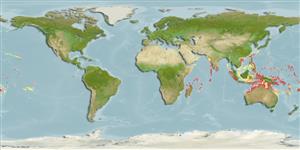>
Gobiiformes (Gobies) >
Gobiidae (Gobies) > Gobiinae
Etymology: Trimma: Greek, trimma, -atos = something crushed (Ref. 45335); anaima: Name from the Greek 'anaimos', meaning bloodless, pallid, pale or anaemic, referring to the pale, almost washed-out colouration of the species; noun in apposition (Ref. 100726).
More on author: Winterbottom.
Environment: milieu / climate zone / depth range / distribution range
पारिस्थितिकी
समुद्री ड़िमरसल; गहराई सीमा 3 - 35 m (Ref. 90102). Tropical
Indo-West Pacific: Comores, Maldive Islands; to Indonesia, Philippines, Caroline Islands, Papua New Guinea, Western Australia, and Fiji.
आकार / वज़न / Age
Maturity: Lm ? range ? - ? cm
Max length : 3.0 cm SL पुल्लिंग / अलिंग; (Ref. 48637)
पृष्ठीय रीढ़ (सम्पूर्ण): 6 - 7; पृष्ठीय सौफट रेज़ (सम्पूर्ण): 8; गुदा कांटा 1; ऐनल सौफट रेज़: 8. Distinguished by the following characters: a bony interorbital about 2/3 pupil diameter in width and only slightly concave; absence of troughs or trenches in the interorbital or posterodorsal orbital regions; unbranched fifth pelvic-fin ray, 50-60% fourth ray; epaxialis extending anteriorly to a vertical in line with the posterior margin of the orbit (Ref. 100726); no elongated spines; all pectoral rays unbranched; longitudinal scale series 23; absence of predorsal scales on midline; 1-2 deciduous scales on upper opercle; depth of body 4.0-4.1 in SL; semi-translucent pink on upper half of body (straw-yellow, translucent above midlateral septum, Ref. 100726); midlateral stripe is broad and reddish orange in color; breast and belly, white; narrow light blue lines below eye, dorsal midline of snout and behind upper rear corner of eye (Ref. 90102).
Inhabits coastal reef slopes and lagoons. Found along reef margins with rubble (Ref. 48637). Also found in caves and crevices, often on drop-offs in 3-35 m (Ref. 90102). A relatively rare species in collections, usually been taken in lots of one or two specimens (Ref. 100726)..
Life cycle and mating behavior
परिपक्व अवधि | पुनरुत्पत्ति | मछलीऔ का अंडे देना | अंडे | Fecundity | लार्वा
Winterbottom, R. and D.F. Hoese, 2015. A revision of the Australian species of Trimma (Actinopterygii, Gobiidae), with descriptions of six new species and redescriptions of twenty-three valid species. Zootaxa 3934(1):001-102. (Ref. 100726)
IUCN Red List Status (Ref. 130435)
Threat to humans
Harmless
Human uses
अधिक जानकारी
आम नामउपशब्दचपायचयपरभक्षीईकोटोकसीकोलौजीपुनरुत्पत्तिपरिपक्व अवधिमछलीऔ का अंडे देनाSpawning aggregationFecundityअंडेEgg development
संदर्भजलीयकृषिजलीयकृषि रूपरेखाखींचआनुवंशिकीElectrophoresesहैरेटिबिलटीबीमारीप्रक्रमणNutrientsMass conversion
सहयोगीयोतस्वीरेStamps, Coins Misc.ध्वनिसिगुयटिरारफ्तारतैरने के प्रकारगिल क्षेत्रOtolithsदिमागदृष्टि
साधन
Special reports
Download XML
इंटरनेट स्रोत
Estimates based on models
Preferred temperature (Ref.
123201): 26.3 - 28.9, mean 27.8 °C (based on 302 cells).
Phylogenetic diversity index (Ref.
82804): PD
50 = 0.5000 [Uniqueness, from 0.5 = low to 2.0 = high].
Bayesian length-weight: a=0.01023 (0.00477 - 0.02194), b=3.02 (2.84 - 3.20), in cm total length, based on LWR estimates for this (Sub)family-body shape (Ref.
93245).
लौटाव (Ref.
120179): ऊंचा, न्यूनतम जनसंख्या दुगनी समय अवलागत 15 महीने। (Preliminary K or Fecundity.).
Fishing Vulnerability (Ref.
59153): Low vulnerability (10 of 100).
Nutrients (Ref.
124155): Calcium = 868 [367, 2,774] mg/100g; Iron = 2.64 [1.33, 5.75] mg/100g; Protein = 17.4 [15.4, 19.1] %; Omega3 = 0.284 [0.101, 0.699] g/100g; Selenium = 42 [16, 105] μg/100g; VitaminA = 36.4 [9.3, 133.8] μg/100g; Zinc = 3.5 [2.1, 5.7] mg/100g (wet weight);
